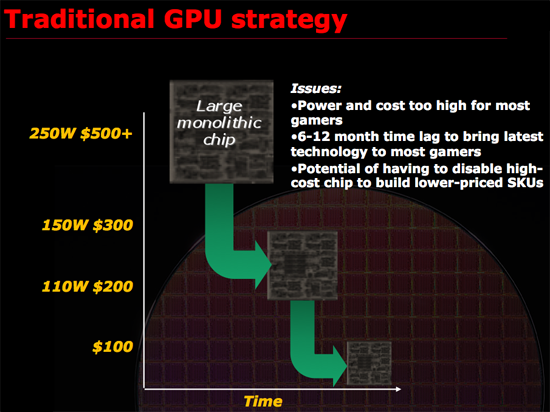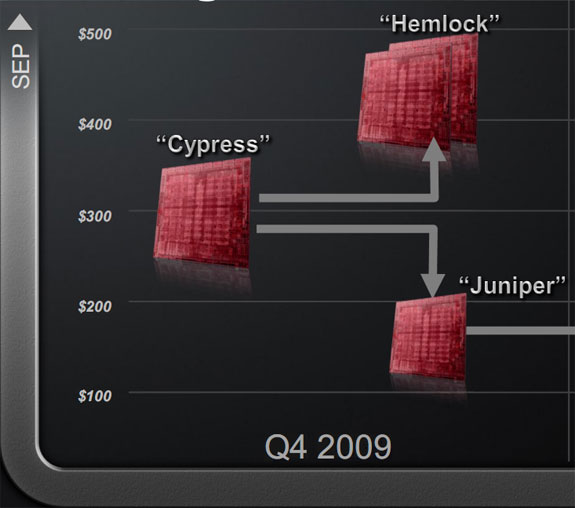The RV870 Story: AMD Showing up to the Fight
by Anand Lal Shimpi on February 14, 2010 12:00 AM EST- Posted in
- GPUs
What Made it All Ok: 4 GPUs in < 6 Months
Through a lot of hard work and sacrifice, even on Carrell’s part, ATI cut the RV870 from as much as 22mm on a side down to roughly 18mm x 18mm. The problem is that RV770 was around 16mm on a side. The RV870 was still too big.
Carrell wanted to cut it down even more, but two things changed his mind. First, in order to build 870 in the space of a 770 ATI would have to cut out much more from the chip than Carrell originally tought. One of the things that would have to go was some of the shader core.
In order to run the GDDR5 memory at the sort of data rates that ATI was targeting for the 5870 the analog PHYs on the chip had to grow considerably. At 16mm on a side ATI would either have to scale back memory bandwidth or eat into the shader core area. Either way we would’ve had a slower chip.
I asked Carrell if 16mm on a side would’ve made the RV870 $100 cheaper at launch, putting it on par with the RV770 launch prices. He said no. I didn’t find out why until much later, but I’ll save that story for another time.
Sacrificing performance to meet the 16mm x 16mm die size targets wasn’t going to happen, but what ultimately convinced Carrell to go with a larger die this time around was something that ATI didn’t get nearly enough praise for: the ability to launch 4 different 40nm DirectX 11 GPUs in less than 6 months.
Remember that Carrell’s beef with building the biggest GPU possible is that it takes too long for the majority of customers to get access to derivatives of that GPU. Look at how long it took G80 or GT200 to scale down. And who knows when we’ll see $150 Fermi/GF100 derivatives.

But ATI Engineering promised two things. First, that Cypress would have a successor called Juniper that would be ready around the same time. Secondly, two more GPUs would follow and the whole stack will be done and out in less than 6 months. ATI came close in 2008 with 3 GPUs in 3 months, but the fourth member of the 4000 series didn’t show up until April of 2009.
It wasn’t an impossible feat. ATI does have concurrent design teams and a lot of engineering resources in India/China. By working on Juniper in tandem with Cypress, assuming there were no show stopping bugs, ATI could exploit efficiencies in two teams effectively working on the same hardware (Juniper was just half a Cypress).
The idea of taking such a huge risk made Carrell uncomfortable. Running two GPU designs in parallel, for the same family of chips, is risky. If everything works out perfectly, you get two chips out at the same time. If it doesn’t, you’ve just tied up two design teams on one product generation. A slip here would give ATI its own Fermi.
What ultimately sold Carrell was the fact that engineering told him that they believed they could pull it off. Carrell believes in people. He believes if you expect the best out of those around you, then that’s what you’ll get. He couldn’t reconcile his beliefs with doubting the schedule engineering was feeding him. Carrell nervously signed off and the Evergreen stack was born.

Cypress and Juniper were delivered nearly at the same time. In fact, Juniper was ready a bit earlier and was sampled to developers months before ATI launched the 5000 series. Cedar and Redwood followed, not to mention a dual-Cypress board that became the Radeon HD 5970. And all of this was done and ready in less than 6 months (the chips themselves were all ready within 4 months).
When the smoke cleared ATI had new DirectX 11 parts at $600, $400, $300, $200, $150, $100 and $60. The Windows 7/DirectX 11 market bulge just got serviced.










132 Comments
View All Comments
tomoyo - Monday, February 15, 2010 - link
Another awesome article about the real situation behind the hardware from you Anand! I was on the USS Hornet and wish I had talked to you, but it was a great time nonetheless. It's interesting the change in their thought process between the RV770 and RV870, I hope they keep the winning streak up for the next refresh cycle (which hopefully will stay on the market bulges).WT - Monday, February 15, 2010 - link
*sigh* ^^^There's always one in the crowd.
Take care in the fact that you are the only person who hasn't enjoyed this read.
MegaManX4 - Monday, February 15, 2010 - link
Reminds me much of the Anglo-Saxon "documantaries", where it is always of tertiary relevance WHAT is actually discussed, but it is always of utmost interest how the responsible person "feels" about what he is just seeing, other than just stating the facts.There seems to be a huge crowd vowing for that kind of journalism, Whatever pleases the canaille.
"Jedem das Seine" or "to each his own" then
MegaManX4 - Monday, February 15, 2010 - link
This was actually the worst article i have ever read at anandtech. I know that you Americans always strive for emotionally .Driven stories, but this outright borders on silly exaggeration."Heroes of our Industry", what a Schmalz.
Also, if one would take the real informations presented in that article, it wouldn't justify even a 2 Page Article, let alone that 11 Page behemoth.
They are engineers, they do their jobs. Nothing more, nothing less.
Greetings from Germany
blowfish - Monday, February 15, 2010 - link
hmm, with an attitude like that you'll never get past middle management!Like most here, I loved this article. Anand obviously has the friendship and respect of some very senior players, and we were treated to some great insights into how things work at AMD ATI.
As the reader, you can choose to read or not read the article, simple as that. Maybe you should up your medication.
MegaManX4 - Monday, February 15, 2010 - link
unreasonable polemicpmonti80 - Monday, February 15, 2010 - link
You are the one being unreasonable. This may not be a "scientifically written" article, but no one is claiming it to be. And that's the reason this article is so interesting.saiga6360 - Thursday, February 18, 2010 - link
Apparently German engineers are just soulless robots. His confusion is understandable.BelardA - Monday, February 15, 2010 - link
I enjoyed this article even more than the RV770. I do recommend that everyone read that one too.Kind of shocking that Nvidia didn't use that info from the RV770 article to learn to NOT make big GPUs like the GTX 2xx. yeah yeah, it takes 2-4 years to design a chip.
I thank ATI (and AMD) for not playing marketing games like Nvidia does... I think they have a bigger marketing department than engineers nowadays. They started with the GF2-MX 400 & GF4-MX cards (which were re-labeled updated GF2 cards that were not up to GF3 standards)... but the latest cluster-muck of Nvidia products is nothing but a mess. 8800 re-badged as a 9800 re-badged into the gts 250. Code-name of NVxx go to G80 to G92 to G100. The GT-1xx products that are actually low-end 9xxx products, same with most G200 & G300. I'm not going to be surprised when the GTX 285 gets renamed into the GTS450 at $200! I've seen people who bought the GTS250 and post on the internet "why isn't my new gts250 much faster than my old 8800GT"... because you bought a faster version of your card and thought it was something new. Wow, 3 years with 3 names for the same product, that is marketing.
ATI does good with the entire 4000 series being DX 10.1 products and 5000s are DX11. (Does anyone really use HD-5xxx?) It doesn't feel like ATI is pulling our chain with their products.
AMD should be learning from ATI, they are getting better with CPUs - 2 years late, but AMD CPUs are now faster than Core2 and compete well against the lower end intel i-confused model CPUs. There is still room for improvement which was recommend to them some time ago, but AMD is just going to come out with a new design for next year. But had AMD tweaked their CPUs a bit for another 10~20% performance, they'd be up there with i7s.
I hope in the next ATI GPU, some form of Physics engine is added to go up against nvidia's PhsyX. But perhaps that'll be part of DX12... but Microsoft no longer supports Games for Windows.
Actually, with more and more games going ONLY to consoles, I don't think the need for high-end gaming cards will be needed anymore in the next few years. If there are no games, who needs a $300 3D Gaming card?
Zink - Monday, February 15, 2010 - link
Would also like to say great article. I can't wait for new distributed computing cores come out optimized for ATI's architectures.